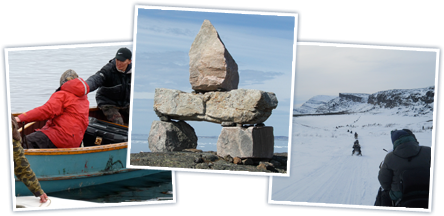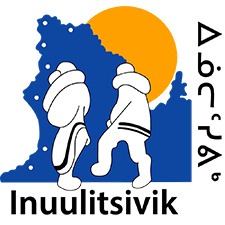
Northern life and Inuit culture
Puvirnituq
PUVIRNITUQ means “putrid”. It is the place where a whole village of Inuit died of hunger one winter; no-one survived to tell of the famine. When the spring came, and with it the thaw, the igloos melted, and by the time the bodies were found the smell was very bad. So the place was called Puvirnituq to commemorate this event, although it is not a very suitable name for a village.
The first Qallunaat did not arrive in Puvirnituq until 1952. At around the same time – although not immediately – the Inuit began to live in houses. They still receive construction materials each year.
The area around Puvirnituq is very flat. There is not much tide and no marine currents, which means there is no delicious seafood to collect, such as mussels or clams. As there are no hills, the sea is not very deep near the coast, and people who are not from the Puvirnituq region are often afraid to travel by sea. Some boats do set out, however. There are light signals, which enable the boats to find their way back to the village without the help of Inuit navigators. Johnny Pov was one of these navigators; he died on December 14, 1978.
The Puvirnitumiut (inhabitants of Puvirnituq) use their traditional language. Very few of them speak English, but there are some who are studying French. The Inuit population of Puvirnituq is about 1418. The village has two churches, one Anglican and the other Catholic, but there is no priest at the moment. In addition, there is a large hospital with three or four doctors and about one hundred other employees, both Inuit and non-Inuit. The hospital also has four experienced midwives, and many women from the Hudson Bay area go to Puvirnituq to give birth to their babies.
There are two stores in Puvirnituq: the cooperative and Northern, which took over from the Hudson’s Bay Company. We also have a museum that exhibits the traditional tools of our ancestors. The museum was officially opened on August 31, 1978, by Camille Laurin, who was then Minister of Indian Affairs in the Parti Québécois government. Project for a new Cultural Center and Museum are on plan.
The inhabitants of Puvirnituq refused the James Bay and Northern Quebec Agreement. In 1975, some Inuit rushed to Québec for the signing of the agreement, which did not take place in Nunavik territory.
These are the reasons that the Puvirnitumiut said no: They do not want to give up their ancestral lands and values, and they are opposed to their territory being used as a place of research by people from another culture. Also, the Inuit use very large territory, covering both land and sea, for hunting and gathering their food.
Today, the Inuit get on better with one another and are working together to develop Nunavik; but in 1975, the time of the Agreement, there were many fierce arguments.
A number of Puvirnitumiut own and use dog teams. The Inuit of Nunavik are happy in their treeless territory, for they are free to go anywhere to hunt. They do not want their land to be destroyed by exploitation, particularly the building of hydro-electric dams.
Location
The northern Inuit village of Puvirnituq, also known by the name of Povungnituk, is located on the northern coast of Povungni tuk Bay, where it meets the river of the same name, east of Hudson Bay, 540 kilometers north of Kuujjuarapik. The territory of Puvirnituq, designated as Category 1 land, is comprised of 626.57 square kilometers. The surface area of the territory and the rights attached to it are defined by the James Bay and Northern Quebec Agreement.
Principal access to Puvirnituq is by airplane.
Presentation
Archeologists have discovered traces of human activity in the area of present-day Puvirnituq, that date back more than 800 years. There was a seasonal camp site on the territory, which most probably went by the name of Tupirvialuk. In the beginning of the 20th century, trading posts for Revillon Frères, and, later, for The Hudson’s Bay Company, were operating about 30 km south of the actual site of Puvirnituq. In 1952, these installations were moved to the present location of the village. A fur trading post in Akulivik was abandoned in 1955, when a series of illnesses nearly wiped out the people who were living there, and the survivors found refuge in Puvirnituq, where they stayed for almost twenty years. Unlike most other Inuit communities in Nunavik, the Puvirniturmiut (the name by which the people of Puvirnituq are known) originally refused to sign the James Bay and Northern Quebec Agreement. The present-day village was incorporated, upon consent of the members of the community, in 1989. The name ” Puvirnituq” can be translated as “smells like rotten meat”.
Administration
Local administration is assured by the municipal council of Puvirnituq, established by the Northern Village Corporation, and the mayor is Mister Johnny Anguitiguluk. The Northern Village of Puvirnituq council is part of the Kativik Regional Authority.
Economy
Seal hunting, fishing and the seasonal hunting of migratory birds are traditional activities which remain important in the Puvirnituq. The local cooperative store is active in retail sales, financial services, stone-carving and sculpture, handicrafts production, the commercial fur trade, the distribution of petroleum products and tourism.
Services
There is a hotel in Puvirnituq that is administered by the Federation of Inui Co-operation of New-Quebec.
Puvirnituq has a community radio station : Puvirnituq Tusauinga, 99.9 MHz.
